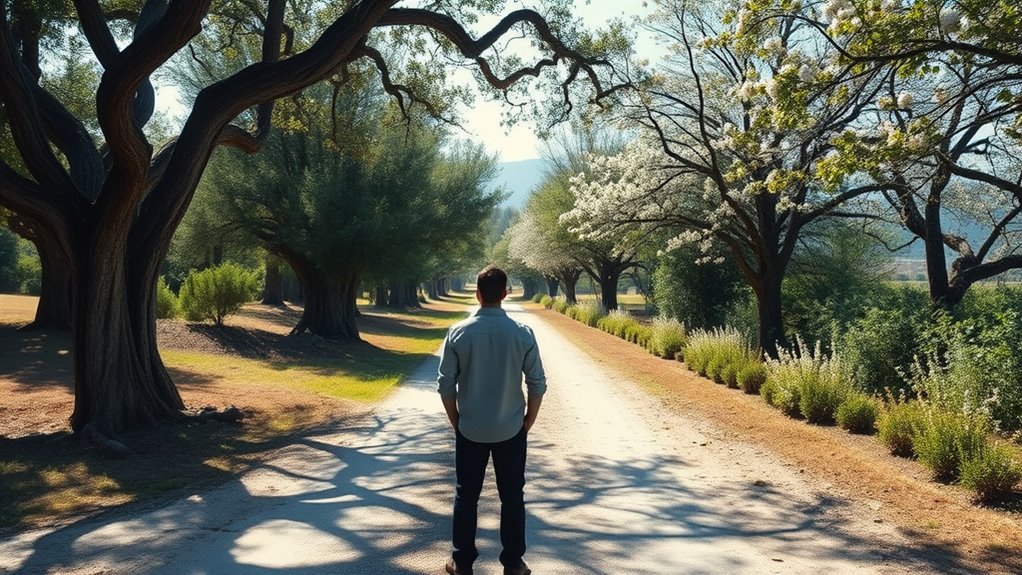You naturally prefer familiar choices because your brain views change as risky, often overestimating potential losses and underestimating gains. This tendency, called status quo bias, is fueled by fear of uncertainty and loss aversion, making routines feel safer and more comfortable. Routines reduce stress and decision fatigue, reinforcing resistance. To move forward, you can learn how strategies and mindset shifts can help you see change as an opportunity rather than a threat. Keep exploring to discover how.
Key Takeaways
- People overestimate potential losses and underestimate benefits, making change seem more risky than staying the same.
- Familiar routines provide comfort and control, leading individuals to perceive change as threatening to stability.
- Loss aversion causes a focus on potential negative outcomes, amplifying perceived risks of change.
- Uncertainty and fear of the unknown heighten perceived dangers, even when change offers advantages.
- Cognitive biases and emotional attachments reinforce preference for the status quo, making change feel inherently riskier.
Understanding the Concept of Status Quo Bias

Have you ever wondered why people often stick with familiar choices even when better options are available? That’s because of the status quo bias, a mental shortcut where you prefer things to stay the same. It’s a natural tendency to resist change, even if new options could improve your situation. You might feel more comfortable with what you know because it reduces uncertainty and perceived risk. This bias influences your decisions daily, from sticking with an old phone plan to avoiding new career opportunities. You might also be influenced by comfort and support solutions that reinforce familiarity. It’s not just about laziness; your brain perceives change as a potential threat to stability. Recognizing this bias helps you understand why change feels uncomfortable and why you might need extra motivation to step outside your comfort zone. Additionally, understanding the role of emotional attachment to routines can shed light on why certain habits are difficult to break. Incorporating self-awareness strategies can help you identify when this bias is affecting your choices and empower you to consider new possibilities. Being aware of behavioral biases, such as the status quo bias, can help you make more informed and deliberate decisions.
The Psychology Behind Our Resistance to Change

You might resist change because you fear losing what you already have, even if the potential gains are clear. Staying in your routine provides comfort and reduces uncertainty, making change feel risky. Cognitive biases, like overestimating losses or underestimating benefits, also influence your hesitation to shift from the status quo. Additionally, the desire for a cohesive and aesthetically pleasing environment can make altering your home decor feel daunting, even when new solutions could improve functionality and style wall organization. Recognizing how divorce proceedings vary and influence your experience can help reduce uncertainty and make adapting to new routines less intimidating.
Fear of Loss
Fear of loss plays a powerful role in shaping your resistance to change, often causing you to cling to familiar routines even when new options could be better. You tend to focus more on what you might lose—like comfort, stability, or predictability—than on potential gains. This loss aversion makes change feel risky, even if it promises improvements. Your brain perceives potential losses as more significant than equivalent gains, leading you to prefer staying with familiar choices. This emotional response triggers a defensive mindset, where the fear of losing what you already have outweighs the potential benefits of change. Additionally, mindfulness techniques can help you become more aware of these emotional responses and better manage your reactions to risk. Recognizing emotional responses and understanding how they influence your decisions can help you reframe your perspective on change. As a result, you may avoid taking risks, sticking with the status quo to protect yourself from perceived harm or disappointment.
Comfort in Routine
Why do familiar routines feel so reassuring, even when they no longer serve us? It’s because routines create a sense of predictability and control. When you stick to what you know, your brain reduces uncertainty, making you feel safer. This comfort comes from the brain’s preference for efficiency—relying on habits requires less mental effort than *finding your way through* new situations. Over time, routines become ingrained, offering a familiar structure that minimizes stress and decision fatigue. Even if your current routine isn’t ideal, breaking free feels risky because it threatens this sense of stability. This psychological comfort makes change feel *intimidating*, prompting you to cling to familiar patterns—even when they no longer benefit you. The desire for stability keeps you anchored in routines, reinforcing resistance to change. Additionally, return policies across retailers often favor sticking with what’s familiar, further discouraging change. Research in attune magazine indicates that the brain’s preference for routines is deeply rooted in neural efficiency, making it challenging to adapt to new behaviors. Furthermore, habit formation is reinforced through consistent behavior, making deviations seem more daunting. Familiarity with electric bikes and their features also contributes to the comfort of sticking with known choices, as understanding their capabilities reduces perceived risks in switching or upgrading.
Cognitive Biases at Play
Cognitive biases strongly influence our resistance to change by shaping how we perceive risks and benefits. You tend to overestimate potential negatives and undervalue possible gains, making change seem more formidable than it truly is. Loss aversion, for example, makes you prioritize avoiding losses over acquiring equivalent gains, so you cling to familiar routines. The status quo bias pushes you to prefer current situations, even if alternatives are better. Confirmation bias leads you to focus on information that supports existing habits, ignoring evidence that suggests change could be beneficial. These biases create mental shortcuts that skew your perception, making change appear riskier and less worthwhile. Additionally, social influences demonstrate how the opinions of peers can reinforce resistance to change, even when new approaches are advantageous. Recognizing these biases helps you understand why change feels so daunting, even when it might ultimately be advantageous. Being aware of cognitive biases like these can empower you to challenge automatic negative thoughts about change.
How Fear of Uncertainty Amplifies Risk Perception

When uncertainty surrounds a decision, it often heightens your perception of risk, making potential threats seem more severe than they might actually be. Your fear of the unknown causes your mind to focus on worst-case scenarios, amplifying perceived dangers. This reaction can lead you to overestimate risks, such as:
- Believing that trying something new will inevitably lead to failure or loss.
- Thinking that change will bring unpredictable and uncontrollable negative outcomes.
- Feeling overwhelmed by the possibility of regret or making a costly mistake.
- Trauma management techniques from somatic therapy can help you process underlying fears that contribute to risk perception. Incorporating remote work strategies into your lifestyle can also reduce stress and make change feel more manageable. Recognizing how emotions influence risk perception can empower you to approach change with greater confidence and clarity. Additionally, understanding the health benefits of fruit juice varieties, such as reducing inflammation or supporting immune function, can encourage a more positive outlook toward embracing new choices.
The Role of Loss Aversion in Avoiding Change

Fear of uncertainty often leads people to overemphasize potential losses, making loss aversion a powerful force in avoiding change. When faced with the idea of switching routines or adopting new methods, your brain tends to focus on what could go wrong. This bias makes losses feel more significant than equivalent gains, so you prefer to stay with what’s familiar. You might believe that changing could lead to setbacks or failures, even if the potential benefits are substantial. As a result, you resist stepping outside your comfort zone, fearing the immediate pain of loss more than the potential long-term gains. Recognizing this bias can help you evaluate risks more objectively, especially when considering modern trends in tableware that encourage innovation and sustainability. Additionally, understanding home furnishings safety can reassure you that new options—like heated mattress pads—are designed with safety features to minimize risks, making change less daunting. Being aware of angel number soulmates and their messages can also provide reassurance that positive change aligns with your spiritual path and personal growth. Furthermore, understanding the importance of contrast ratio in projectors can help you see that sometimes, the perceived risks are less significant than they seem, especially when the benefits of higher image quality outweigh the initial hesitation. Loss aversion keeps you anchored in the status quo, often preventing growth and innovation.
Common Situations Where We Prefer Routine

You often stick to routines because they make your workday predictable and less stressful. Daily habits also provide comfort, reducing the effort needed to decide what to do next. Recognizing these tendencies helps you understand why change feels so challenging. This tendency is similar to status quo bias, where individuals prefer to maintain their current situation to avoid perceived risks.
Workplace Routine Comfort
Workplace routine comfort often stems from the familiarity and predictability of daily tasks, which can make you feel more secure and efficient. Sticking to routines reduces uncertainty and helps you avoid mistakes. You might avoid change for these reasons:
- Fear of the unknown—uncertainty about new methods can cause anxiety.
- Confidence in current skills—you trust what you already know.
- Avoiding disruption—change might temporarily hinder productivity or comfort.
- Engaging in consistent routines can also be reinforced by industry trends that favor stability over experimentation. Additionally, the tendency to favor familiar tools and processes, like using the same paint sprayer tips or following established cleaning routines, further reinforces comfort in routines.
Furthermore, the desire for predictability can be strengthened by status quo bias, which makes deviations from routine seem riskier than they actually are. These feelings create a strong pull to stick with what’s familiar, even if better options exist. Comfort zones provide a sense of mastery and control, making it harder to embrace new strategies. This desire for stability often outweighs the potential benefits of change, keeping you anchored to routines that feel safe.
Daily Habit Resistance
Daily routines often feel more appealing because they eliminate the need to make constant decisions and face uncertainty. When you stick to familiar habits, you avoid the mental effort of choosing new options, which can seem overwhelming. This comfort in predictability reduces stress and saves time, making routines feel safer. You might resist trying a new workout, changing your morning schedule, or switching brands at the grocery store because the current choices feel familiar and safe. Your brain prefers routine because it minimizes risks and potential mistakes. While this resistance offers short-term comfort, it can also prevent growth and new opportunities. Recognizing this tendency helps you understand why change feels intimidating, even when it might lead to better results.
Recognizing When Bias Affects Decision-Making

Recognizing when bias affects decision-making requires developing an awareness of subtle mental shortcuts that influence choices. You might notice feelings of hesitation or anxiety whenever faced with change, signaling bias at play. Pay attention to these signs:
- Avoiding new options because they seem unfamiliar or risky.
- Relying on past choices, even when circumstances change.
- Feeling uneasy about making decisions that differ from the status quo.
These reactions often stem from subconscious biases, making it hard to see opportunities clearly. By tuning into your emotional responses and questioning why you prefer the familiar, you can start to identify when bias influences your decisions. Recognizing these signals is the first step toward making more mindful, balanced choices.
Strategies to Overcome the Fear of Change

Overcoming the fear of change requires deliberate strategies that shift your mindset and build confidence in new options. Start by breaking down your change into smaller, manageable steps. This makes the process less overwhelming and helps you see progress along the way. Reframe your perspective by focusing on potential benefits rather than risks. Visualize successful outcomes to boost your confidence. Seek support from others who have experienced similar changes; their insights can reassure you. Practice mindfulness to manage anxiety and stay grounded during progressions. Finally, remind yourself that discomfort is temporary and that growth often comes through stepping outside your comfort zone. These strategies can help you approach change with a more open, resilient attitude, reducing fear and increasing your chances of success.
Real-Life Examples of Underestimating Change Risks

Many people underestimate the risks involved in change, believing that the benefits will outweigh any potential setbacks. Take these real-life examples:
Underestimating change risks can lead to costly, overwhelming setbacks.
- A company switches to a new software system without thorough testing, risking major disruptions and lost productivity.
- An individual quits a stable job for a startup, only to face financial instability and stress.
- A government implements a policy change rapidly, leading to public backlash and unintended consequences.
These stories show how underestimated risks can lead to costly mistakes. You might think change is an opportunity with minimal danger, but ignoring potential setbacks can cause setbacks that feel overwhelming. Recognizing these risks upfront helps you make smarter decisions and prepares you for challenges ahead.
Practical Tips for Embracing Positive Change

Embracing positive change becomes easier when you take deliberate, practical steps to prepare yourself. Start by setting clear, achievable goals to give yourself direction and motivation. Break down big changes into smaller, manageable tasks to avoid feeling overwhelmed. Seek support from friends, family, or mentors who can offer encouragement and guidance. Practice mindfulness to stay present and reduce anxiety about the unknown. Remind yourself of past successes in adapting to change, reinforcing your confidence. Keep a positive outlook by focusing on potential benefits rather than risks. Track your progress regularly to stay motivated and make adjustments as needed. These small, intentional actions help build resilience and make embracing change feel less intimidating.
Cultivating a Growth Mindset to Challenge the Bias

By embracing learning opportunities, you can shift your perspective and see challenges as chances to grow. Reframing failure as a step toward success helps you develop resilient thinking and reduces fear of making mistakes. Cultivating this mindset empowers you to challenge the status quo and pursue continuous improvement.
Embrace Learning Opportunities
To challenge the status quo bias, you need to actively seek out learning opportunities that push you beyond your comfort zone. Embracing new challenges fuels growth and diminishes fear of change. Start by:
- Tackling unfamiliar tasks that stretch your skills and confidence.
- Seeking feedback from others to identify blind spots and improve.
- Reflecting on setbacks as chances to learn, not failures.
Each step helps you build resilience and opens your mind to possibilities previously overlooked. When you view learning as a continuous journey, you weaken the grip of the status quo. Remember, growth happens outside your comfort zone, and every new challenge is an opportunity to evolve. Embracing learning transforms your perspective, making change less intimidating and more rewarding.
Reframe Failure as Growth
Failure is often seen as a setback, but rethinking it as an essential part of growth can transform your mindset. When you view mistakes as learning opportunities rather than final failures, you open yourself to progress. Shift your perspective from avoiding failure to embracing it as a step forward. Visualize your journey:
| Failure as a setback | Failure as a growth step |
|---|---|
| Stalls progress | Fuels improvement |
| Creates fear | Sparks curiosity |
| Feels final | Feels temporary |
| Leads to doubt | Builds resilience |
Cultivate Resilient Thinking
Reframing failure as a growth step encourages you to develop resilient thinking, which strengthens your ability to bounce back from setbacks. When you adopt a growth mindset, you see challenges as opportunities, not threats. This shift helps you:
- Recognize your ability to improve with effort, boosting confidence.
- Embrace mistakes as valuable lessons that fuel your progress.
- Persist through difficulties, knowing setbacks are part of growth.
Frequently Asked Questions
Can Status Quo Bias Impact Financial Decision-Making?
You might find that sticking to familiar financial choices feels safer, even if better options exist. This tendency can lead you to avoid switching investments or exploring new opportunities, potentially limiting your growth. Status quo bias makes you perceive change as riskier than it truly is, causing you to miss out on benefits. Recognizing this bias helps you make more confident, informed decisions and avoid unnecessary hesitation.
How Does Status Quo Bias Influence Organizational Change?
When considering organizational change, you might find yourself hesitant to move away from familiar processes. Your tendency to prefer the current state can make you see change as more risky than it truly is. This bias can slow innovation and adaptation, as you focus on potential losses rather than benefits. Recognizing this tendency helps you evaluate change more objectively, encouraging you to take necessary steps for growth without unnecessary fear.
Are Certain Personality Types More Prone to This Bias?
You might find that certain personality types are more prone to avoiding change, especially those who value stability or fear uncertainty. If you’re naturally cautious or dislike risk, you tend to prefer sticking with familiar routines. These traits make you more susceptible to the bias that change is risky, even when it’s not. Recognizing this can help you challenge your assumptions and become more open to new opportunities.
What Role Does Culture Play in Resistance to Change?
You might find that your culture heavily influences how you perceive change. If your environment values tradition and stability, you’re more likely to resist new ideas or methods. Culture shapes your attitudes, making change seem riskier or unnecessary. When change conflicts with your cultural norms or collective identity, you may instinctively resist it, even if it could bring positive outcomes. Understanding this helps you see resistance as more about cultural comfort than actual risk.
How Long Does It Typically Take to Overcome This Bias?
Imagine breaking free from a heavy fog that obscures your view—overcoming this bias takes time. Usually, it can take several months to years, depending on your environment and willingness to adapt. You’ll face resistance like gusts pushing you back, but persistence clears the haze. With consistent effort, your confidence grows, and the fear of change diminishes, revealing brighter horizons ahead. Patience is your guiding compass through this transformation.
Conclusion
Just as Icarus hesitated before flying too close to the sun, your instinct may resist change out of fear. But remember, progress often requires stepping beyond familiar wings. By understanding your biases and embracing growth, you can soar above the safety of routine. Don’t let the shadows of uncertainty keep you grounded—trust in your capacity to adapt and thrive, just like the hero who dared to challenge the skies.










